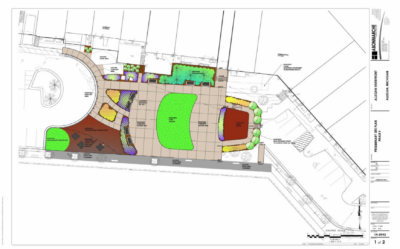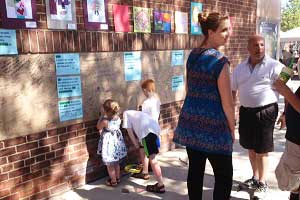PlacePlans: What have we learned so far?
By: Richard Murphy,
April 29, 2015
We’re proud to be part of Michigan’s leadership in building on place, but that doesn’t mean we’re content to rest on our laurels or pretend we’ve got everything figured out. We’re still learning as we go, and updating our practice as we figure out what’s working well and what needs more attention in our communities. As a result, many of the projects in this year’s third cycle of the PlacePlans program look very different from the initial pilots!
Yesterday, at the Building Michigan Communities conference, I was joined by some of our on-the-ground partners to talk about the different types of projects we’ve undertaken, and how the program has grown:

Allegan’s first phase of construction shows the evolution from the vision created during their PlacePlans design process to the nuts and bolts of engineering considerations.
Rob Hillard, city manager of Allegan, hosted one of our first PlacePlans projects: in 2012, we first teamed up with the team of physical space design experts from MSU’s School of Planning, Design, and Construction to look at the City of Allegan’s downtown waterfront. Allegan is one of our best-case scenarios: less than 6 months after the PlacePlans team wrapped up work, local voters approved removing $500,000 from the city’s sinking fund to seed implementation, and the city was able to leverage that to secure another $567,000 from other sources: the city is currently out to bid for the first phase of construction, which will create a public plaza with stage and amphitheater while “both reducing and improving parking.” Even while we see this as a successful move from our work to results, watching Rob’s follow-through helped us understand how we needed to look at funding scenarios–and getting potential funders involved–early in the process to support that transition. With that in mind, we’ve kept Samantha busy in her new role as President of the League’s Foundation.
We also decided that, while the design process worked well for Allegan, it wasn’t the type of support that many of our cities were stating a need for. Laura Lam, community and economic development director for Kalamazoo, talked about her experience in the second round of PlacePlans, when we assembled teams of private consulting firms to address targeted needs in some of our cities.

LSL’s transportation expertise helped Kalamazoo weigh trade-offs within the existing bounds of Portage Street: the city will be undertaking a trial reconfiguration of the street this summer in advance of a planned reconstruction.
The City of Kalamazoo is acting on several of the recommendations from our work, but perhaps the biggest impacts will come from the engagement of the neighborhood’s anchor institutions, such as and Bronson Hospital, which has committed to reduce driving and parking demand to their campus and is hiring a bicycle coordinator in support of that goal. To make those connections, we had to change directions mid-stream in our work to catch up to and coordinate with related discussions that KVCC was hosting around the development of their new Healthy Living Campus. This year’s approach to our work in Saginaw is strongly shaped by that experience: sometimes all the right pieces are already on the table, and figuring out how to put them together is more important than bringing anything novel.

Berkley addressed ambivalence over turning a downtown street into a festival plaza by jumping in and trying it out.
Finally, Sarah Szurpicki, a partner with New Solutions Group, talked about the projects that her team facilitated in Berkley and Utica last summer. These two cities had pitched us projects that we liked, but that weren’t quite ready for the full PlacePlans approach, so we engaged Sarah to help them road-test some ideas. Not only did this help the cities figure out where to take these project, but our experience with those cities’ stakeholder groups helped us organize community members better in all of our projects: we’ve added a “community steering committee” to most of our PlacePlans this year, to make sure we’re not missing any voices or opportunities. Additionally, these two cities reinforced that small-scale efforts need to be exceptionally focused: Berkley’s project gave clearer direction for next steps because it was tightly focused on a single downtown block.
We’ll probably never do PlacePlans the same way two years in a row, and that’s a good thing: it means that, even with our successes, we keep figuring out how we could do better with the next one.